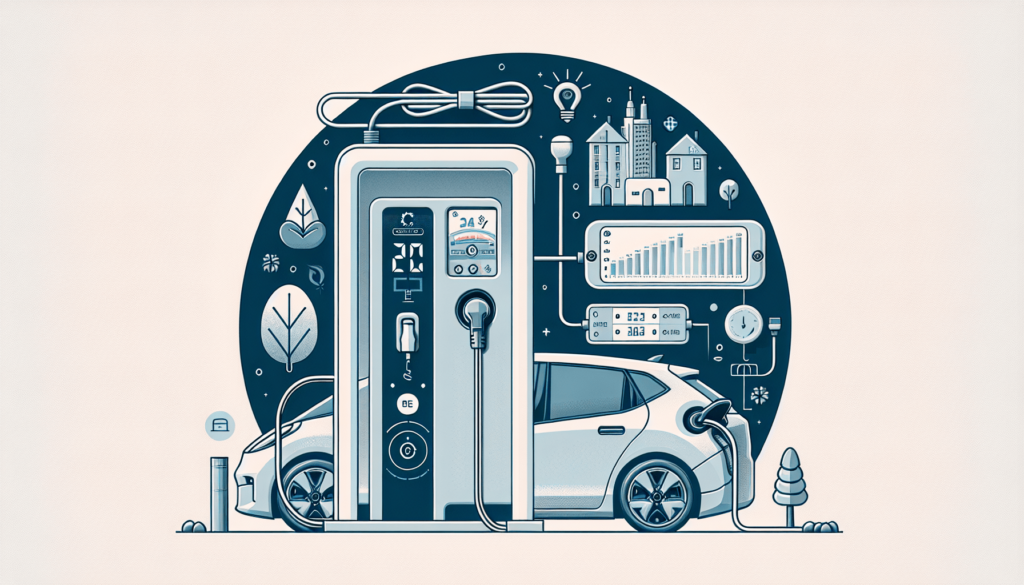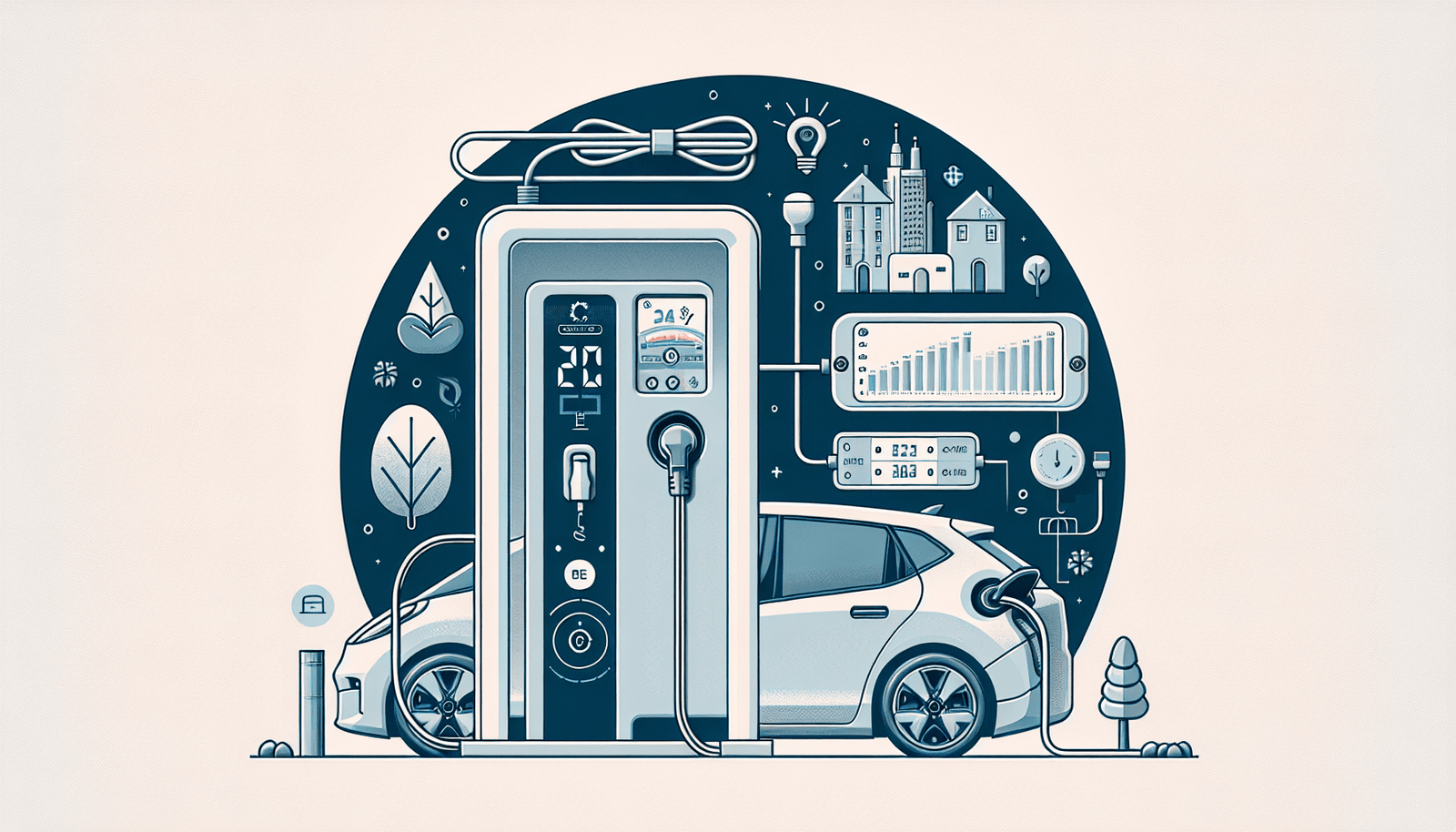Imagine being the proud owner of an electric vehicle (EV), cruising down the road in a silent and eco-friendly car. But have you ever wondered how EV owners manage their charging costs and energy consumption? In a world where sustainability is becoming increasingly important, this article will explore the strategies and techniques that EV owners employ to keep their cars powered up without breaking the bank. Whether it’s taking advantage of off-peak charging rates or utilizing smart charging technologies, discover the fascinating ways in which EV owners are revolutionizing the way we consume energy.

Understanding Electric Vehicle Charging Costs
Electric vehicle charging costs depend on various factors, including the charging option chosen and the time of use tariffs. By understanding these cost factors, you can effectively manage and control your charging expenses.
Cost Factors for Electric Vehicle Charging
When it comes to electric vehicle charging costs, the primary factors to consider are the electricity rate charged by your utility company and the efficiency of your vehicle’s charging system. It’s important to check the pricing structure of your utility provider to determine the cost per kilowatt-hour (kWh) for charging your electric vehicle. Additionally, the charging efficiency of your vehicle can impact the overall cost, as some vehicles may require more electricity to fully charge compared to others.
Different Charging Options and Their Costs
There are various charging options available to electric vehicle owners, each with its own associated costs. These options include home charging, public charging infrastructure, and workplace charging. Home charging is often the most convenient and cost-effective choice, as you have control over the pricing and can take advantage of off-peak electricity rates. Public charging stations usually charge a fee per kilowatt-hour or per session, while workplace charging may be provided by your employer at no cost or a subsidized rate.
Managing Charging Costs with Time-of-Use Tariffs
One effective way to control electric vehicle charging costs is by taking advantage of time-of-use tariffs offered by utility companies. These tariffs provide different electricity rates depending on the time of day, with lower rates during off-peak hours. By scheduling your vehicle charging during these lower-cost periods, you can significantly reduce your overall charging expenses. It’s worth considering whether your utility company offers time-of-use tariffs and analyzing your charging patterns to make the most of this cost-saving opportunity.
Controlling Energy Consumption
In addition to managing charging costs, electric vehicle owners can also take steps to control their overall energy consumption. This involves monitoring energy usage, optimizing charging times, and utilizing smart charging solutions.
Monitoring Energy Usage
It’s essential to keep track of your energy usage to understand how much electricity your electric vehicle consumes. This can be done through the use of energy monitoring devices that provide real-time data on your charging sessions. By regularly monitoring your energy usage, you can identify any unexpected spikes or inefficiencies and adjust your charging behavior accordingly.
Optimizing Charging Times
Optimizing your charging times can play a significant role in energy consumption management. By charging your vehicle during off-peak hours when electricity rates are lower, you can efficiently utilize cheaper electricity. Additionally, some electric vehicle models offer features that allow you to schedule charging at specific times, enabling you to take advantage of time-of-use tariffs and further reduce costs.
Using Smart Charging Solutions
Smart charging solutions utilize advanced technologies to optimize charging based on factors such as energy pricing, grid demand, and renewable energy availability. These solutions allow you to control and monitor your charging remotely, ensuring your vehicle charges when electricity costs are lower or when renewable energy generation is at its peak. By utilizing smart charging solutions, you can actively contribute to a more efficient and sustainable energy grid while managing your charging costs effectively.
Planning Charging Stations Accessibility
Ensuring that electric vehicle charging stations are easily accessible is crucial for a seamless charging experience. This involves considering home charging options, evaluating public charging infrastructure, and utilizing workplace charging opportunities.
Considerations for Home Charging
For many electric vehicle owners, home charging is the most convenient and cost-effective solution. When planning home charging, consider the installation of a dedicated charging station or upgrading your existing electrical infrastructure to support faster charging speeds. It’s also important to explore any local regulations or permits that may be required for the installation.
Public Charging Infrastructure
Public charging stations play a crucial role in expanding the charging network and providing charging options for electric vehicle owners who don’t have convenient access to home charging. When evaluating public charging infrastructure, consider the proximity of charging stations to your regular routes and destinations. Also, take note of the pricing structure, as some charging stations may charge a flat fee or have varying rates based on charging speed.
Utilizing Workplace Charging
Workplace charging is becoming increasingly popular as employers recognize the benefits of supporting electric vehicle ownership. If your workplace offers charging facilities, take advantage of this convenient and often cost-effective option. Check whether there are any restrictions or requirements for using the workplace charging stations and explore payment options or incentives provided by your employer.
Taking Advantage of Incentives and Rebates
Governments and utility companies often offer incentives and rebates to encourage electric vehicle adoption and support the growth of charging infrastructure. By taking advantage of these programs, you can save money on upfront costs and ongoing charging expenses.
Government Incentives for Electric Vehicle Charging
Government incentives for electric vehicle charging can come in the form of tax credits, grants, or rebates. These incentives may cover a portion of the costs associated with purchasing and installing home charging stations or public charging infrastructure. It’s important to research and understand the specific incentives available in your locality to maximize the financial benefits of owning an electric vehicle.
Utility Company Programs and Rebates
Utility companies also play a significant role in supporting electric vehicle charging by offering programs and rebates. These can range from discounted electricity rates for electric vehicle charging during off-peak hours to financial incentives for installing home charging stations. Visit your utility company’s website or reach out to their customer service department to learn about any available programs or rebates that can help reduce your charging costs.
Participating in Demand Response Programs
Demand response programs allow electric vehicle owners to contribute to grid stability by adjusting their charging patterns in response to grid demand. By enrolling in these programs, you may receive financial incentives or credits for charging your vehicle when demand is low or during periods of high renewable energy generation. Participating in demand response programs not only reduces your charging costs but also helps promote a more sustainable energy system.

Leveraging Renewable Energy Sources
One of the key advantages of electric vehicles is their potential to reduce greenhouse gas emissions when powered by renewable energy sources. By harnessing renewable energy for your electric vehicle charging, you can further mitigate environmental impact and potentially reduce long-term charging expenses.
Installing Solar Panels for Home Charging
Installing solar panels on your property allows you to generate clean, renewable energy to power your electric vehicle. When considering solar panel installation, assess your property’s solar potential and consult with reputable solar companies to determine the best system size and configuration for your needs. By producing your electricity, you can significantly reduce or even eliminate the cost of charging your electric vehicle.
Utilizing Renewable Energy Tariffs
If installing solar panels is not feasible for your situation, consider enrolling in renewable energy tariffs offered by your utility company. These tariffs ensure that a percentage of the electricity supplied to your home comes from renewable sources. By subscribing to a renewable energy tariff, you can indirectly support renewable energy generation and reduce the environmental impact of your electric vehicle charging.
Connecting to Off-Grid Power Sources
In remote areas or situations where access to the grid is limited, connecting your electric vehicle to off-grid power sources can be a viable option. This can include utilizing small-scale wind turbines, hydroelectric generators, or portable solar panels. Off-grid charging solutions provide independence from traditional energy infrastructure and allow you to charge your electric vehicle wherever you go, ensuring a reliable energy source in off-grid locations.
Utilizing Energy Management Apps
Energy management apps provide convenient tools and features to monitor and control your electric vehicle charging and energy consumption. These apps integrate with your charging equipment, gather real-time data, and offer insights to optimize your charging experience.
Overview of Energy Management Apps
Energy management apps are specifically designed to help electric vehicle owners track and manage their charging costs and energy consumption. These apps typically connect to your electric vehicle, charging station, or smart meter, allowing you to monitor charging sessions, track energy usage, and analyze charging efficiency.
Features and Benefits of Popular Apps
Popular energy management apps offer a range of features to enhance your electric vehicle charging experience. These features may include real-time charging status updates, notifications when charging is complete, scheduling options for time-of-use tariff optimization, and historical data analytics to identify patterns and optimize charging behavior. Some apps even provide integration with smart home systems, allowing you to control your charging remotely using voice commands or through a centralized smart home hub.
Integration with Smart Home Systems
Integrating energy management apps with smart home systems can further streamline your charging and energy management. By connecting your electric vehicle charging with other smart devices in your home, you can automate charging schedules, adjust energy usage based on household patterns, and even optimize charging to coincide with the availability of renewable energy.
Implementing Energy-Saving Practices
Adopting energy-saving practices in your daily driving and charging routines can have a significant impact on both your charging costs and overall energy consumption. By making conscious choices and implementing efficient habits, you can maximize your electric vehicle’s efficiency and minimize energy waste.
Driving Efficiently
Driving efficiently is one of the most effective ways to reduce energy consumption and extend your electric vehicle’s range. This includes practices such as avoiding rapid acceleration and heavy braking, maintaining a steady speed, and utilizing regenerative braking whenever possible. By practicing efficient driving techniques, you can make the most of every kilowatt-hour and significantly reduce your charging costs.
Reducing Phantom Loads
Phantom loads, also known as standby power or vampire power, refer to the electricity consumed by devices even when they are not actively in use. Unplugging chargers and devices not in use can prevent unnecessary energy consumption and reduce your overall electricity bills. By eliminating phantom loads, you can minimize energy waste and optimize your charging costs.
Preconditioning and Climate Control
Preconditioning your electric vehicle before driving can help optimize energy usage and reduce the reliance on climate control systems while driving. By preheating or precooling your vehicle while plugged into a charging station, you can rely on the grid’s electricity instead of your vehicle’s battery to reach your desired cabin temperature. This reduces the strain on the battery and ensures more energy is available for driving, ultimately maximizing your electric vehicle’s efficiency and range.
Maintaining Battery Health
Maintaining the health and longevity of your electric vehicle’s battery is crucial to optimize performance and minimize additional costs. By following best practices for battery care, you can extend its lifespan and maintain optimal charging levels.
Optimal Charging Levels
To maintain battery health, it is recommended to charge your electric vehicle between 20% and 80% of its capacity whenever possible. Frequent charging within this range helps preserve battery life and ensures a consistent and reliable charge. Avoiding both full discharges and keeping the battery at maximum charge for extended periods helps minimize stress on the battery cells, ultimately prolonging its lifespan.
Avoiding Extreme Temperatures
Extreme temperatures can significantly impact battery performance and longevity. Avoid exposing your electric vehicle to excessively high or low temperatures, as this can degrade the battery’s capacity and overall health. Whenever possible, park your vehicle in shaded areas or garages, especially during extreme weather conditions, to reduce the strain on the battery and maintain optimal performance.
Regular Battery Maintenance
Performing regular maintenance on your electric vehicle’s battery is essential for its long-term health. This includes following manufacturer-recommended maintenance schedules, such as checking and maintaining proper coolant levels, ensuring appropriate charging equipment compatibility, and inspecting for any signs of damage or deterioration. By prioritizing battery maintenance, you can maximize its efficiency and minimize the risk of unexpected repair costs.
Understanding Electric Vehicle Efficiency
Understanding the factors that affect electric vehicle (EV) efficiency can help you optimize your driving habits and maximize your EV’s range. By monitoring and improving efficiency, you can make the most of each charge and reduce energy consumption.
Factors Affecting EV Efficiency
Several factors impact electric vehicle efficiency, including driving conditions, vehicle weight, aerodynamics, and tire pressure. Factors such as aggressive driving, frequent stops and starts, driving uphill, and carrying excess weight can decrease efficiency and reduce your EV’s range. Maintaining proper tire pressure, reducing unnecessary vehicle weight, and maintaining a smooth driving style can all contribute to improved efficiency.
Monitoring and Improving Efficiency
Monitoring your electric vehicle’s efficiency through onboard vehicle data or dedicated apps can provide valuable insights into your driving habits and energy consumption. These tools can display real-time efficiency metrics, such as energy usage per mile or kilometer, and highlight areas for improvement. By actively monitoring and making adjustments to your driving style or habits, you can become more efficient and maximize your electric vehicle’s range.
Efficient Driving Techniques
Adopting efficient driving techniques is crucial for enhancing electric vehicle efficiency. Some key techniques include minimizing the use of climate control systems, maintaining a consistent speed, anticipating traffic flow to minimize braking and accelerating, and utilizing regenerative braking. By incorporating these techniques into your driving routine, you can significantly increase your EV’s range and reduce charging costs.
Evaluating the Total Cost of Ownership
When considering the purchase of an electric vehicle, it’s essential to evaluate the total cost of ownership to make an informed decision. While electric vehicles often have a higher upfront cost compared to gasoline vehicles, there are several factors that contribute to long-term savings.
Comparing Electric and Gasoline Vehicles
Electric vehicles typically have higher upfront costs compared to equivalent gasoline vehicles due to the cost of batteries and specialized components. However, electric vehicles offer lower maintenance costs, reduced fuel costs, and potential savings from incentives and rebates. When evaluating the total cost of ownership, it’s necessary to consider factors such as fuel or electricity prices, maintenance and repair expenses, and the potential resale value of the vehicle.
Considering Long-Term Savings
Electric vehicles can provide long-term savings due to reduced fuel costs and lower maintenance expenses. Electricity generally costs less than gasoline, and the rising availability of renewable energy can further reduce charging expenses. Additionally, electric vehicles have fewer moving parts and require less frequent maintenance compared to internal combustion engine vehicles, resulting in lower maintenance costs over the vehicle’s lifespan.
Factoring in Maintenance Costs
When comparing electric and gasoline vehicles, it’s crucial to consider maintenance costs. Electric vehicles have fewer components, such as oil filters, spark plugs, and timing belts, which need regular replacement, resulting in reduced maintenance expenses. Additionally, regenerative braking in electric vehicles can reduce wear on the brake pads, further extending maintenance intervals. By factoring in the lower maintenance costs of electric vehicles, the total cost of ownership can be more favorable compared to gasoline vehicles.
Electric vehicle owners have several strategies at their disposal to manage charging costs and control energy consumption effectively. By understanding the cost factors for charging, utilizing different charging options, and taking advantage of incentives, you can optimize your charging expenses. Monitoring energy usage, optimizing charging times, and using smart charging solutions provide additional control over energy consumption. Considering home charging, public charging infrastructure, and workplace charging options ensures easy accessibility to charging stations. Leveraging renewable energy sources, such as solar panels and renewable energy tariffs, contributes to a greener and potentially more cost-effective charging experience. Energy management apps, energy-saving practices, battery maintenance, and efficient driving techniques all play a vital role in managing energy consumption and maximizing electric vehicle efficiency. Finally, evaluating the total cost of ownership, comparing electric and gasoline vehicles, and factoring in long-term savings and maintenance costs allow for informed decision-making when considering electric vehicle ownership. With these comprehensive strategies in place, you can navigate the world of electric vehicle charging and energy consumption with confidence and efficiency.

